Last Updated on October 30, 2024 by Owen McGab Enaohwo
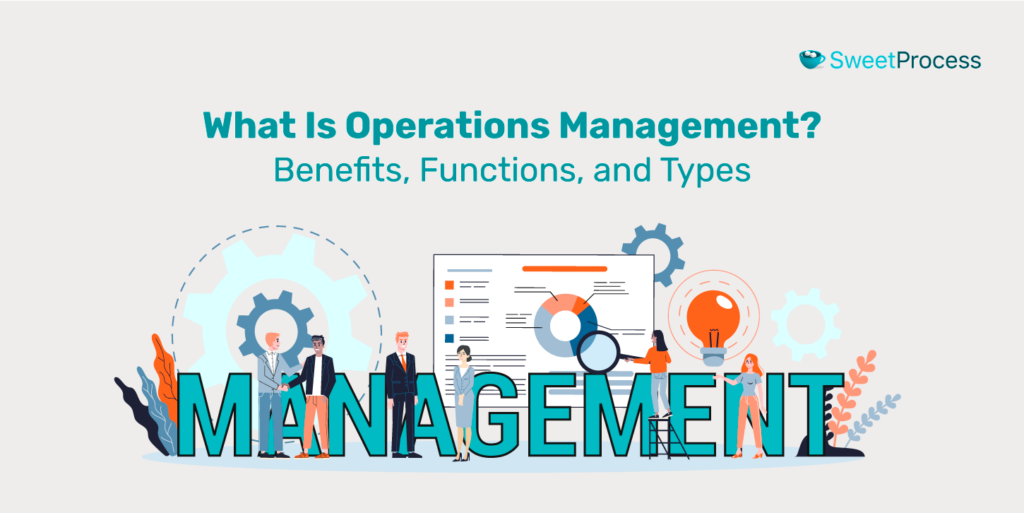
Harvard Business School Professor Marco Lansiti defines operations management as the power to act.
He heads the university’s Technology and Operations Management Unit and says the operations department creates, captures, and shares value for customers, shareholders, and the entire business ecosystem. He adds that software and data transform the systems that define and deliver that value to various economic agents.
If you are putting in 55 to 90 hours a week yet not enjoying your operating environment, this is your catch-up guide. It will introduce your operations department to tools like SweetProcess that will keep you afloat in this decade’s unpredictable, disruptive, and volatile business environment.
Click here to claim your 14-day free trial of SweetProcess and see how it enhances your operations management. No credit card is required.
Table of Contents – Operations Management Full Guide
What Is Operations Management?
Key Functions of Operations Management in an Organization
Essential Skills You Need to Succeed as an Operations Manager
How SweetProcess Can Make Your Job Easier as an Operations Manager
Types of Operations Management
Major Performance Objectives of Operations Management
Frameworks for Analyzing Operations Management
Challenges of Operations Management (And How to Overcome Them)
Factors Influencing the Performance of Operations Management
Manage Your Business Operations Effectively Using SweetProcess
What is Operations Management?
Operations management (OM) delivers the power to act by linking process and value. Operations managers, therefore, plan, organize, and supervise manufacturing and production. However, their decisions are only efficient when they utilize the least resources to create shareholder value and satisfy customer demands.
Magdi Batato, Nestlé’s head of operations, defines the operations management office tasks as strategic or tactical decision-making. OM department heads make big-picture, long-term impact strategic decisions like the reallocation of capital or the entrance into a new market. Their management expertise is also of immense value in logical points like distribution, logistics, manufacturing, and sourcing where the rubber meets the road.
Why Is Operations Management Important?
Enhances Team Collaboration

An excellent case study on the benefits of a modern operations management model is Nestlé. Nestlé has over 350 factories in diverse locations all over the globe. Its workforce has crossed the 275,000 range.
So, how do the operations management offices in the world’s largest food and beverage company marshal their forces and give all its team members the power to act? In 60 of its factories, all operators have iPads. These tools ensure staff leverages software platforms to create team-based, flexible, and comprehensive operations manuals.
For instance, business process management (BPM) tools improve collaboration by enhancing process visibility. Nestlé operators use their iPads as car dashboards, giving them a sense of ownership of the factory floor and its processes. Here, they can track progress, check task status, and spot any growing bottlenecks instantly.
Helps Achieve Business Objectives
Nestlé’s products have found a cozy spot in just about any household. Their modern approach to operations management supports fast decision-making. It streamlines processes and saves revenue by lowering inefficiencies. Operations management also focuses on quality control and enhancing customer satisfaction.
Boosts Employee Productivity
Concern over employee productivity is a significant challenge that keeps many operations managers up at night. How can you keep your teams working better and faster without exerting undue performance pressure on their heads?
The best business process platforms can keep your employees engaged and in learning mode after their training sessions. They can easily log in to mobile gadgets, read, and then apply their tribal knowledge to the everyday business process.
Information will lower work errors and enhance the speed of task accomplishment. Over and above that, these operations management tools will provide clear task assignments and outline steps to workflow efficiency.
Lastly, they support a conducive work environment by fostering an operator-centric organization. For instance, at Nestlé, devices provide skill building that instills a culture of honesty and transparency into every operator and factory manager through continual learning and upskilling initiatives.
Improves Customer Satisfaction
You would be forgiven for thinking customer satisfaction is the marketing and sales department’s task. However, the largest key performance index with the most significant impact on customer satisfaction is first call resolution (FCR).
First call resolution is a metric that tracks your ability to resolve your customers’ challenges after first contact. Higher FCR rates are a product of equipping your customer-facing task force with adequate data at the right time. Automation and real-time guidance processes and data will enhance your customer experience at a rate of 1% for every 1% improvement you make in your FCR processes.
If your operations manual templates fail to enhance FCR, customer satisfaction will drop by 15% each time a client or buyer calls for updates about an old issue. To this end, knowledge base features in SweetProcess’s standard operating procedure tool can share your team’s collective knowledge on problem resolution.
According to Atlassian, knowledge-based support teams have 15% better first-call resolution rates. In addition to that, an operations management team can ensure timely and consistent delivery of products, fostering loyalty amongst users.
Reduces Costs
Most businesses, especially SMEs, have finite resources and must put their budgetary, technological, material, and financial allocations to their best use. Operations management teams can lower operational costs by embracing technology.
Digital technology, for instance, can lower travel allowances and expand remote workforces, downsizing costs of office space and travel. These platforms can pinpoint hazardous tasks and processes and lower health and safety costs.
The operations management teams can also optimize processes by eliminating activities that do not add value. Lastly, an operations team should leverage systems that provide insight into services or products that provide the best returns.
Ensures Product Quality
Operations management enhances product quality by monitoring and enhancing production. On top of that, they implement a high quality control system that adheres to regulations and meets customer expectations and product reputation.
They will, for instance, note any defects and ensure they are rectified. Then they will create standard operating procedures for all production processes and ensure all production teams have access. They will also monitor these processes, identifying deviations and upskilling employee knowledge through training and feedback loops.
Increases Revenue
Over and above that, businesses with the power to act are agile and adaptable. The core principle of shared data workflows is that they should scale instantly as per demand. They should also split across the organization without imposing more hardware performance challenges and costs.
As a result, your business will enjoy higher productivity and timely delivery of products or services. Better customer satisfaction will ultimately drive higher sales and revenue for the business. For instance, Nestlé’s operations digitization has brought about a consistent operating profit margin of 17% and an earnings-to-share margin of 6% to 10%.
Key Functions of Operations Management in an Organization
1) Strategic Alignment

Say your company plans to increase its market share by increasing its product lines. How does the operations management team align this objective to the organization’s core goals? The team may first increase production capacity to support higher production.
Alternatively, they may focus on streamlining their supply chain processes to ensure a consistent production capacity.
To roll out these objectives, the operations management will first translate these goals into actionable plans.
It will define all key performance indicators (KPI), allocate resources, and optimize them for effective deployment. Data can give you the upper hand, ensuring you can counter threats and actualize opportunities in real-time.
Technology can disperse decision-making to various points where the people close to the action are in your organization. Other strategic alignment roles include quality management, cost efficiency and control, risk management, and performance measurement.
2) Product Design and Delivery
Before 2019, Nestlé India had a single operating model regarding product quality for the entire country. However, its operations management team launched a new model focusing on product quality and satisfaction.
For instance, it broke down its customers into 15 diverse clusters to address regional consumer disconnect. By defining customers through measurable metrics like customer first rather than location first, they began to appeal to consumption occasion, frequency, and equity for various products. As a result, their profits grew by 33.5% in FY20.
Operations management plays a crucial role in product design. It provides manufacturing design, supply chain, and cost insights crucial in product design. After that, the operations team brings the marketing, design, production, and engineering teams together for collaboration.
They also work with the materials team, ramping up resource use measures and roping in the supply chain team for the timely delivery of raw materials. They oversee quality assurance and logistics teams for optimum warehousing, transportation, and distribution networks of goods and services.
3) Process Optimization
Process optimization is your first step toward enhancing and eliminating bottlenecks from your everyday processes. It is a crucial function in the age of fierce competition and endless disruption where efficient use of storage spaces can overcome seemingly insurmountable challenges like space shortages.
Operations managers can, for instance, amend space shortages by analyzing the flaws within the storage process. They will systematically analyze and use flowcharting, process mining, mapping, and simulation to examine and deconstruct the storage process.
Using process optimization, the operations team could, for instance, pinpoint poor warehouse setup as the cause of the storage problem. If your products are fast-moving, they can use pallet racking to build up rather than out. By expanding your space vertically rather than horizontally and using high-reach trucks, you will enjoy more use of your 40-foot-high ceilings.
Reach trucks and other specialized forklifts will quickly access the highest-selling inventory and help streamline your dock-to-stock pipeline. Over and above that, an efficient warehouse management system (WMS) will optimize your processes further and increase agility, compliance, efficiency, and customer satisfaction.
4) Daily Target Achievement
Operations management plays a crucial role in supporting the achievement of daily targets in an organization. The operations team meets this epic challenge by ensuring efficient and effective use of resources. They also optimize processes and focus on key performance indicators (KPIs).
However, the modern operations team does not wait until midyear to analyze progress toward targets. An operations team needs to set daily targets. Day-to-day, one-on-one meetings with the operators regarding training and process efficiencies will enhance target achievement.
Operations managers leverage technology to automate processes and improve efficiency. Manufacturing execution systems (MES) and enterprise resource planning (ERP), for instance, help in real-time tracking and management of daily operations.
Efficient communication through business process management tools like SweetProcess ensures that teams understand their roles and responsibilities.
These tools ensure that operations managers promptly address operational issues to prevent disruptions.
5) Purchasing and Supply Chain Management
Did you know that 69% of businesses do not have the big picture on their supply chain processes? Only 6% of businesses do, yet supply chains are the lifeblood of any organization. They are a crucial cog in the gears of your business and can double your profits and give you a competitive edge in the market.
As per Zippia data, 57% of companies say that efficient supply chain management has given them an edge in commerce. Then, 70% say that good supply chains are a vital KPI for high customer service ratings.
Operations management plans are vital in aligning, optimizing, and integrating an organization’s purchasing and supply chain activities. Coordinating between these functions is essential for ensuring a smooth flow of materials, timely deliveries, and cost-effective operations.
The operations management team analyzes performance metrics and highlights any areas of the supply chain that require further visibility. Their major task is aligning the organization’s strategic goals with the procurement and supply chain teams. They also build robust relationships with the purchasing and cost control teams to ensure fast delivery of items and cost-effective supply chain practices.
6) Project Planning and Control
Projects are brief processes that create value for a business by developing unique services or products. Therefore, the operations and project teams create value for the business by introducing or improving existing products. Since operations management views all business processes via the lens of efficiency, they are vital in project planning and control.
They provide the frameworks, processes, and oversight to ensure that projects are executed efficiently and meet their objectives. Some vital project planning and control tasks for the OM team include resource allocation and capacity planning.
Operations managers also work with project managers to develop realistic timelines for project activities. They contribute to risk assessment and management strategies to ensure project success.
7) Scheduling and Task Management

Operations management is critical in supporting an organization’s scheduling and task management. Firstly, scheduling is a process that deconstructs a project into its activities, milestones, and deliverables. The scheduling team then determines a project’s duration and start and end date.
In addition, the operations team factors a project’s resources into its scheduling processes. The operations team can leverage the master project, milestone, or detailed schedule to identify and track a project’s activity.
They will use project scheduling software to generate easy-to-use Gantt charts that display a variety of views and details of a schedule. Other useful project management tools include the critical path method (CPM) that tracks each project’s most essential tasks sequentially.
On the other hand, the program evaluation and review technique (PERT) leverages mapping tools to map all of a project’s activities. Like a Gantt chart, it is more suited to initializing your project’s task management and scheduling needs. The Gannt chart, on the other hand, is handy when reviewing a project’s milestones during its lifetime.
Some benefits of scheduling include tracking progress and enhancing team collaboration. Then operations management uses task scheduling platforms to highlight concerns, monitor progress, and identify and designate task relationships.
8) Material and Equipment Management
Do you know materials and equipment account for at least 60% of your business costs? For this reason, operations management must use the best standard operating procedures to manage this valuable resource. Materials management is vital to the effortless flow of products to the customer level. Material and equipment management also balances out any conflicts in material availability.
It also lowers inventory costs and enhances customer satisfaction. Material and equipment management operations include inventory, purchasing, warehouse, and transportation management. Material requirements planning (MRP) is a digital technology management objective that uses lead times to plan the production and procurement of materials.
9) Capacity Management
Operations management gives organizations the power to act and maximize their activities by ensuring they have the right resources, including workforce, equipment, technology, and facilities, to meet current and future demand efficiently.
Operations may undertake a capacity management study of your IT needs to ensure that each department has adequate capacity to meet the year’s projected workloads.
Capacity management also balances an organization’s production capabilities with the level of demand for its products or services. It optimizes the use of resources to achieve the highest possible output while maintaining quality standards and efficiency. The main forms of capacity planning include product, workforce, and tool capacity planning.
10) Productivity Management
As the business world adjusts to the post-pandemic environment, productivity has become one of the most significant hurdles every organization faces. For instance, as per Microsoft data, Teams meetings have escalated by a massive 192% in the hybrid work model. Heavy meeting software users spend at least eight hours each week, or an entire workday period, in online meetings.
The multinational technology corporation states that the rising onslaught of meetings has become the leading distraction in the workplace. Distractions hurt productivity and lower employee morale. Business, therefore, needs productivity management to ensure that its labor, capital, and outputs are put to productive use.
Operations management can achieve this feat by enhancing communication and giving team ownership and accountability over work. They should identify a team’s weaknesses and strengths and use project management tools to boost productivity.
Reward and constructive feedback systems also improve productivity and keep employees motivated. The benefits of productivity management include lower overhead costs, better time to market, and more profits for all stakeholders.
Essential Skills You Need to Succeed as an Operations Manager

Analytics
Operations managers analyze and interpret data to ensure that their organizations have the power to act. For instance, operations managers track cash flows, sales transactions, customer accounts, shipments, and supply chain tasks via the best business platforms. Consequently, an operations manager should develop knowledge of business data computing platforms to track all business functions.
Risk Analysis
As per Big 4 audit firms, some of the modern business’s existential risks include data security, IT governance, and cybersecurity. There are also escalating risks in talent management, workplace diversity, and human capital management.
Moreover, ESG (environmental, social, and governance) reports will soon become compulsory in all business spheres. Any unprepared business will face regulatory risks. An operations manager should perform mitigation and risk analysis to highlight potential risks and generate solutions should these challenges arise.
The modern operations management model should also ensure that businesses respond to unforeseeable risks by keeping in close contact with the people closest to the threat radius through technology.
Strategic Planning
Strategic planning develops long-term direction and broad goals that align an organization with its objectives. Consequently, an operations manager must integrate departments like finance, human resources, accounting, and marketing into strategy management.
Data analysis is core to strategic management. Therefore, an operations manager must perform an economic and industry data analysis to provide positive insights in the planning phase. Then they will host quarterly or monthly strategic management planning meetings with all stakeholders to discuss a strategy’s functional and financial vision with all stakeholders.
Decision-Making
The operations management office has five major decision-making spheres. They include policymaking in the physical production process. They also make short-, medium-, and long-term decisions on their organization’s output capacity. Operations management also makes logistical decisions on inventory and the workforce. Lastly, they oversee the control and planning of quality.
Budget Management
Businesses have a variety of budgets that include operating, master, static, cash, financial, production, and labor budgets. The operating budget identifies a business’s projected expenses and revenues. It ensures that the organization sticks within its overall operating budget.
For this reason, an operations team has to prepare their operating budget at the start of the fiscal year. However, in the turbulent business environment of the day, they also have to leverage technology to disperse real-time budgetary decision-making points to all corners of the business. This advantage will ensure that you respond to all disruptions in the business environment.
Skills you need to make company budgets include understanding financial concepts and analytical skills—strong mathematical skills to perform budgeting-related calculations such as percentages, ratios, and forecasting. Then you need budgeting and accounting software to streamline the budgeting process. You also should adhere to ethical standards when handling financial information and making budgetary decisions.
Problem-Solving
Business problem-solving is both a process and an inner ability. Operators with robust problem-solving abilities are more productive and creative in the workplace. However, since problem-solving involves a series of processes, any manager can increase job fulfillment and satisfy their clients through analysis, communication, adaptability, and teamwork. They can write standard operating procedures that identify problems and explore potential solutions by defining goals and objectives.
Communication
Effective communication helps operation managers to manage relationships with all stakeholders in a business. For instance, suppose team members fail to fulfill a task outlined in a process. You would send them a short email about the missed step and why they must repeat it. While at it, you could mention that these repetitions exert undue pressure on company resources.
This communication process has failed the test of effective communication by, for instance, not using positive language, communicating aggression rather than assertiveness, and failing to ask questions. For instance, open questions in an email may help staff speak freely and elaborate on challenges that hinder them from effectively fulfilling a process.
Effective communication in business involves clear and concise expression of ideas, active listening, empathy, and adaptability. It requires transparency, organization, and an appropriate choice of tone. Nonverbal cues, cultural sensitivity, and the use of technology play crucial roles.
Leadership
Some operational managers have a natural affinity for leadership. That said, there is a growing realization that leaders are made through mentorship and educational experiences. Ultimately, a combination of interpersonal skills, strategic thinking, and a commitment to personal and team growth contributes to effective leadership in the managerial role.
Organization
Operations managers should hone their organizational skills to prioritize tasks efficiently. Top-notch organizational skills will help you create and maintain clear systems and set realistic goals. In addition to that, you should learn to leverage tools and technologies to streamline workflows and ensure effective time management.
Then, developing information, documents, and schedules for organizational systems is vital. Continuously assess and refine processes for greater efficiency, and lead by example in maintaining a well-organized work environment.
Product Development
Product development oversees the product lifecycle while bringing new products to the market. An operations manager requires attention to detail, communication, and problem-solving skills. These skills will ensure you can control product development and quality costs and stick to timelines.
You will use your product development skills to create appealing, functional products that resonate with the needs of your clientele. You will achieve positive outcomes by conducting prototype testing and continuous learning. You will refine and enhance your product development skills by staying abreast of industry trends.
How SweetProcess Can Make Your Job Easier as an Operations Manager

How to Map Out and Document Your Company’s Procedures and Processes using SweetProcess
Let us imagine that you are facing persistent quality control challenges. After intensive research, you find out that you need a process that controls the delivery of fresh raw materials. You must ensure that the products you receive from your suppliers are contamination and damage-free. You can build a quality control process on SweetProcess in an instant.
- Log in to your SweetProcess account (you can do this straight from your 14-day free trial)
- Use the Add Teams feature to select the teams you will share your process with. Click on the “Add Teams” button on the bottom right.
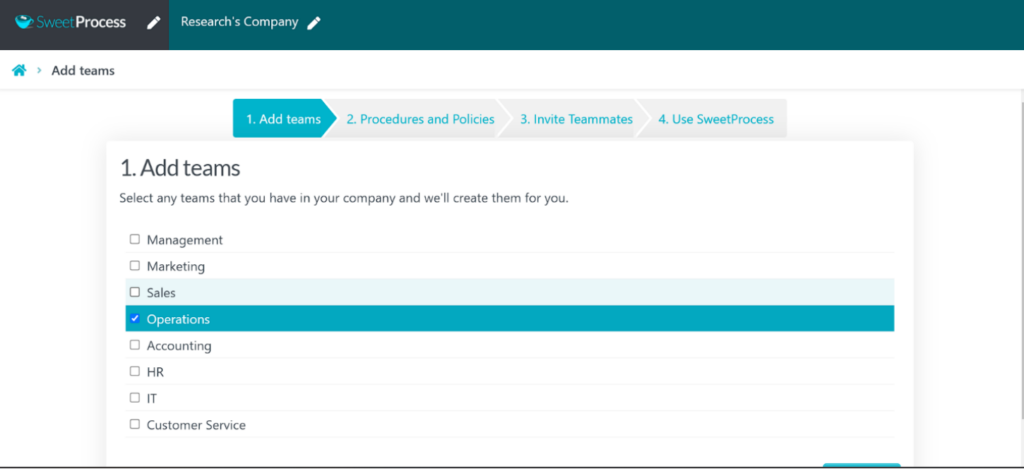
- Next, use the Procedures and Policies tab to look up or create processes that tackle your quality assurance challenge.
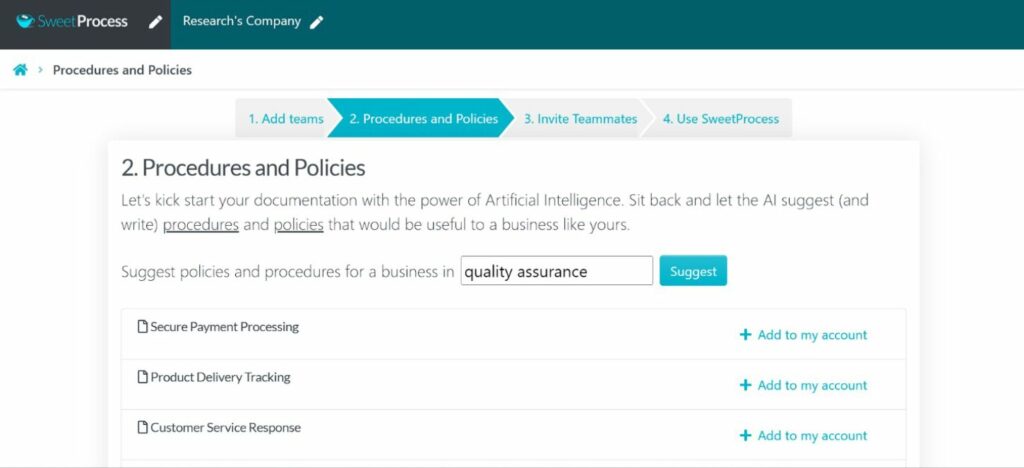
- We chose the Quality Control Checks process from the list of possible procedures and policies and added it to our account.
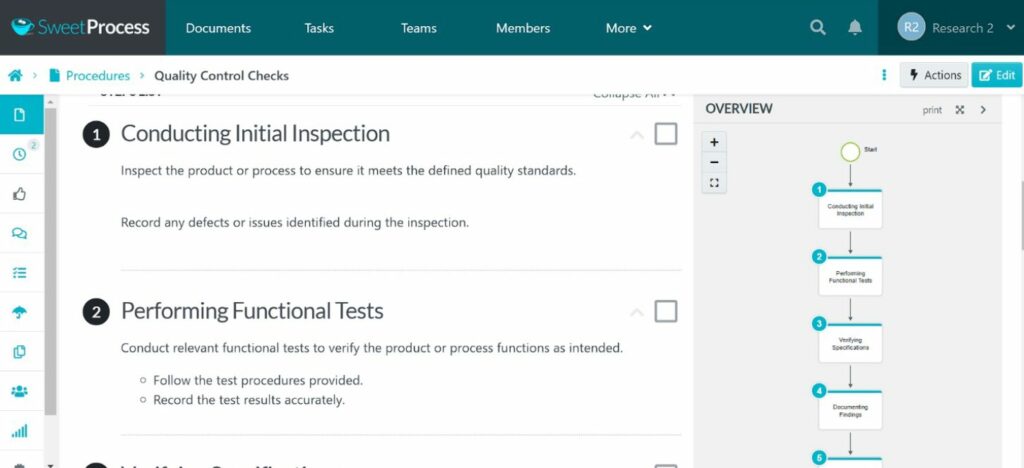
- The SweetProcess AI wrote our process in minutes.
Alternatively, you can create your process manually using SweetProcess’s easy-to-use interface.
- Log in to your SweetProcess account and click the “More” tab.
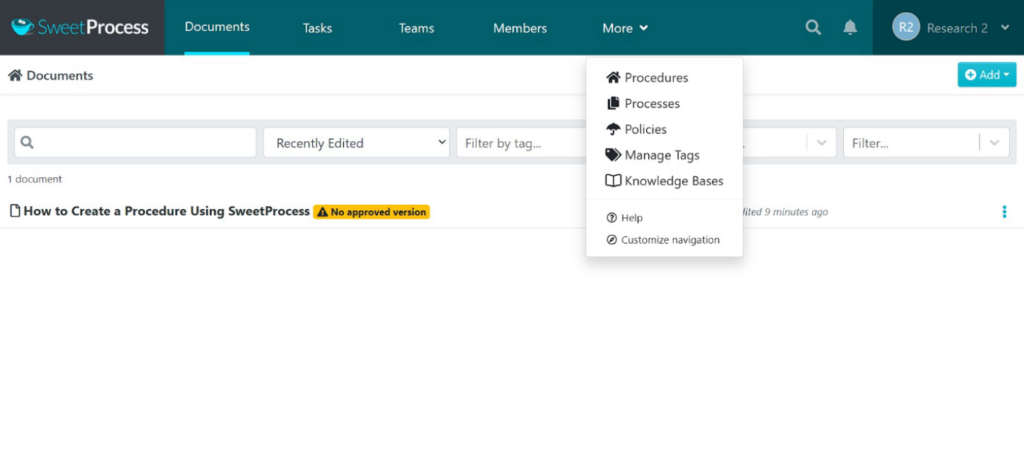
- Select “Processes,” and click the “Create Process” button at the top right.
- Type in your process title. In this case, we choose “Quality Assurance Process for Raw Material Integrity” as our header.
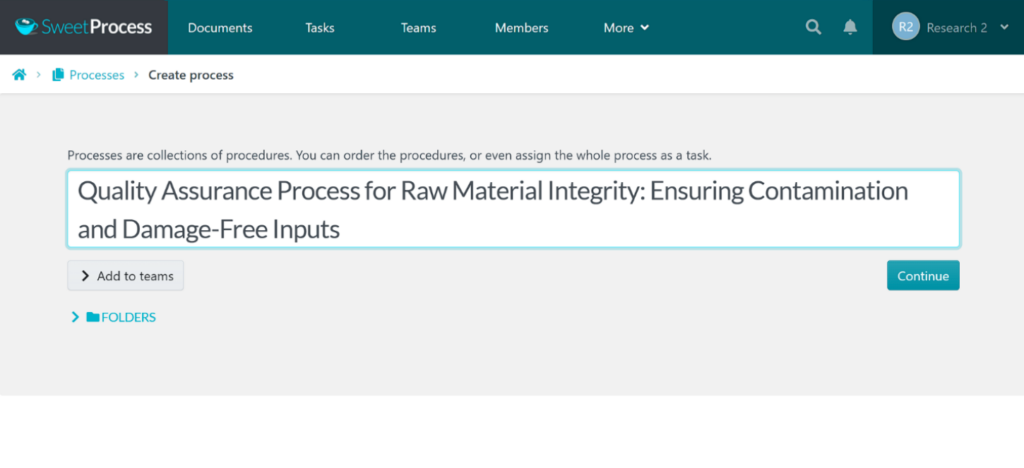
- Break down your task into simple, digestible steps.
- Click on the “Create Process” button.
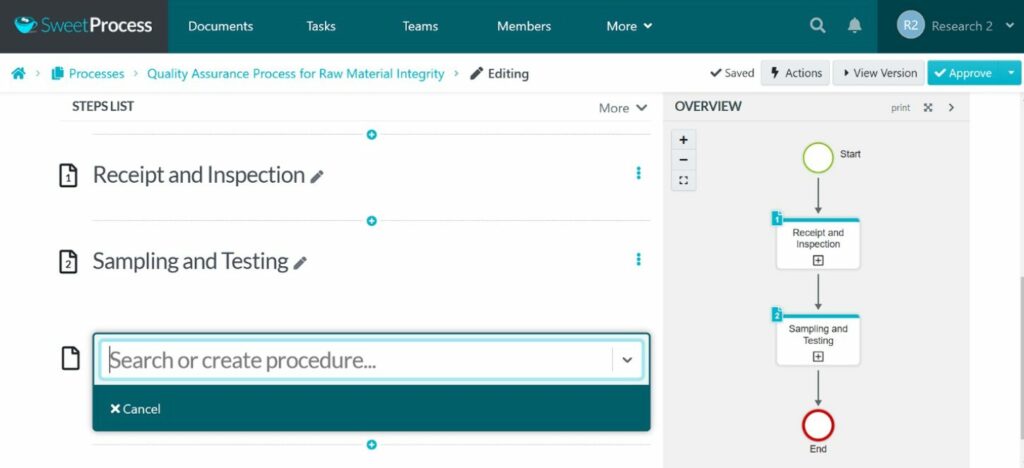
- After that, use the “Add step” button to add a sequence of steps to your process.
- SweetProcess will quickly generate a visual process map.
You can add decisions to your procedures. Decisions use conditional logic or “yes-no” branching to generate guidance options based on the reader’s choice. Click the “Add a Step” button and select the “Add a Decision” tab.
- Click “Finished Editing” and approve your process.
How to Collaborate With Team Members in Real-Time Using SweetProcess
When Katie became Preferred Home Services’ customer experience director, she found SweetProcess was being used for process documentation. Soon, Katie learned that her team members had not explored SweetProcess’s full potential.
She not only deployed SweetProcess to every corner of her organization but explored its effective task assignments and collaboration features. Today, her team members have all their questions about unfamiliar tasks answered in real time.
Like Katie’s team, you can use the “More” tab in the navigation bar to select teams you want to collaborate with:
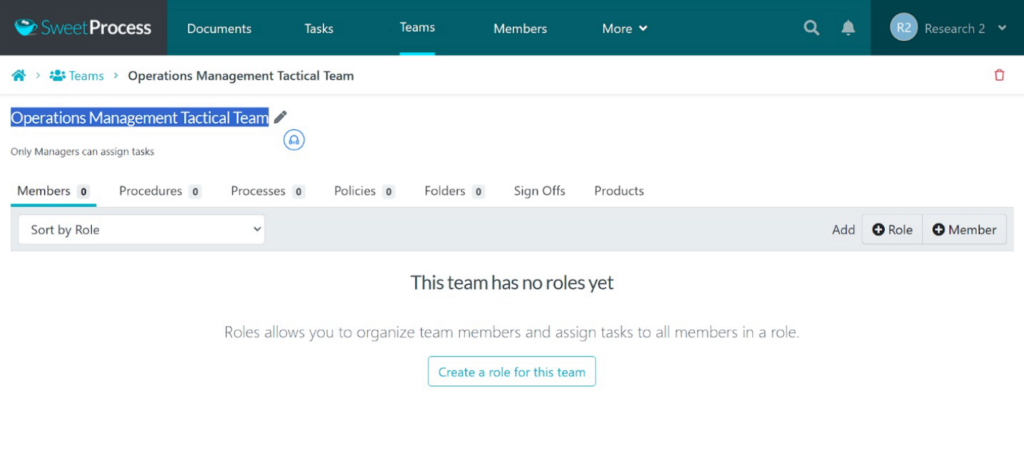
Create your new team and assign its roles. Add members to your new role and assign them teammate or super manager status.
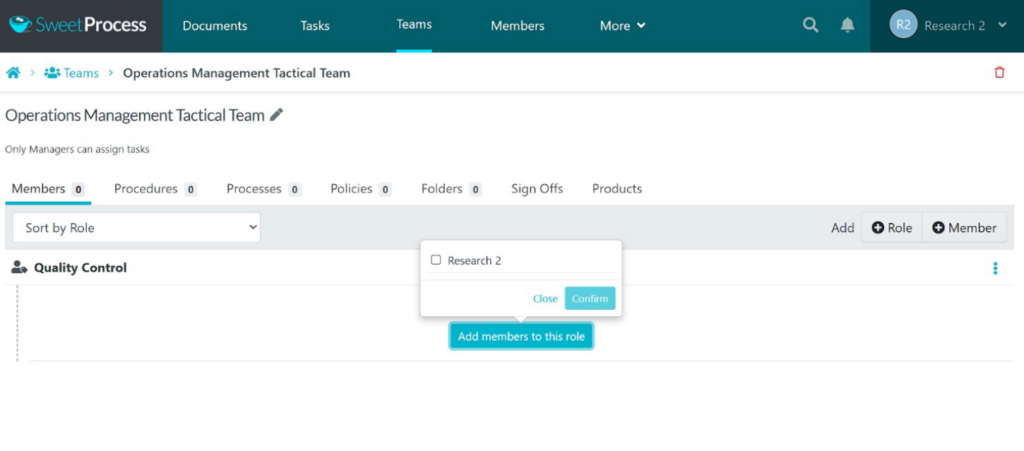
Now they can make comments and will be notified via email to respond to comments from other team members. They can either log in and comment using the SweetProcess interface or reply to the comment via email.
How to Track and Monitor the Progress of the Tasks Assigned to Team Members in SweetProcess
The team at Benchmark Wealth Management had brilliant talent on board, but their operations management team needed to deal with the standardization of standards across their team members.
Sarah Beach, their branch operations manager, first did away with storing tribal knowledge in notebooks. Instead, they digitized their processes using SweetProcess and streamlined their documenting processes. Then she worked on enhancing collaboration among team members. Now, while Sarah has fewer knocks at her office door, her teams sit in one digital room and address each other’s pain points on SweetProcess.
Our process documentation software has sweet tracking features, ensuring all team members complete their tasks. You can create one-off or repetitive tasks that you can assign collectively to all teams or individually using the super manager status.
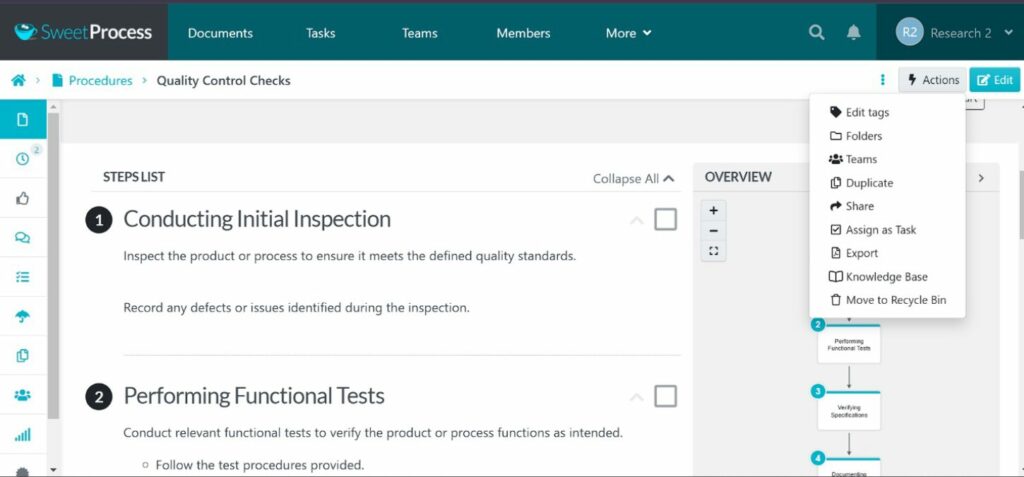
To assign a task to your team, use the three-dots menu on the top right of your process. Alternatively, use the “Actions” menu and click “Share.”
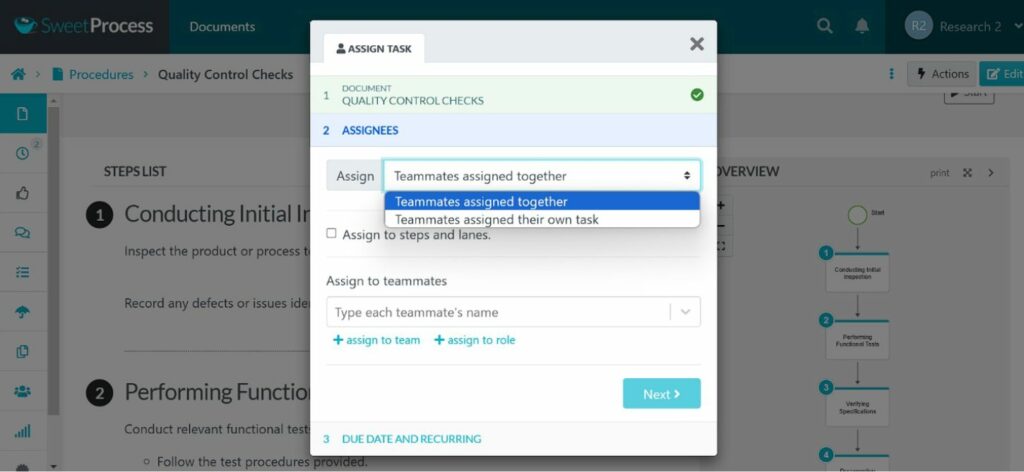
Try out SweetProcess’s process documentation, task management, and collaboration features via their demo page or a 14-day free trial period.
Types of Operations Management
Objectives Management
Objectives management, or strategic control, is a top-level operational management function that monitors company strategy as it undergoes implementation. Objectives management also evaluates any deviations from the strategy and reins them through adjustments.
So, say your organization’s flagship product is on the verge of becoming obsolete. How do you leverage objectives management to reassess your strategy and make a quick save on your bottom line? Top management steps in and reviews the business environment and the demise of the product on the firm’s survival.
Then they formulate adequate goals and new strategies by monitoring external and internal forces through the operational management office’s power to act or data.
Any major errors at the objectives management level are often fatal to business objectives. For instance, when BlackBerry’s objectives management team chose to position their flagship product in the cell phone market, they lost their envious position to the iPhone.
Task Management
Task management, or operational control, oversees intermediate processes, keeping them in tune with pre-established objectives. Task managers use internal data pipelines, enforcing corrective actions at various production levels.
Some task management objectives include a choice of logistics equipment or stock management. Any oversight at this level will translate to delays, low morale amongst workers, and falling sales revenue.
Individual Supervision
Individual supervision ensures that the organization meets its overall strategy. Ground-level supervisors oversee the individual efforts of all team members, interacting with them and passing on instructions from the task management team. Real-time data and a robust operational management team can mitigate risks that lead to the loss of short-term opportunities in a competitive business ecosystem.
Major Performance Objectives of Operations Management

Quality
Did you know that staff and customers base their expectations of your business on the quality of your products or services? Quality is a consistent indicator of your organization’s integrity, performance, and customer satisfaction. It is, therefore, a crucial operations management principle that lowers costs and increases customer satisfaction.
Speed
Speed goes in hand with quality. Faster turnarounds that do not compromise on quality save costs. It is also an integral component of your buyer’s decision-making process. You will enjoy more revenue if you deliver your service or product right when they are ready to purchase. On top of that, your business will rely less on inventories and lower forecasting errors.
Dependability
Do you make your promises and keep them? As we stated, your customer experience rates rise at 1% for every 1% improvement you make in your first call resolution processes. Your customers expect you to anticipate their needs at every turn.
For instance, if your purchase order cycle time is nine days, lowering that cycle time can improve your overall process turnaround and enhance customer satisfaction rates. For this reason, Amazon has invested heavily in logistics, placing 185 fulfillment centers in various places globally. At least 110 of these centers are in the US to ensure that its Prime premium delivery service, which comprises 71% of its clientele, enjoys an exceptional two-day delivery lead time at zero fees.
Cost
Low business cost is every operations management’s objective since low prices attract more sales. So, operations teams must strive to lower the indirect and direct business costs to provide lower price tags for the market. In addition, cost minimization liberates resources that can meet other business objectives.
Flexibility
According to Magdi Batato, Nestlé’s head of operations, operational management teams need to adopt the principle of subsidiarity. In political and social circles, subsidiarity implies that central authorities allow local operatives closest to the input and output centers to make decisions. By doing so, a business will achieve flexibility that enables rapid response to threats or opportunities in the market.
Frameworks for Analyzing Operations Management
Value Chain
Value chain analysis is a systematic framework that identifies your customer’s most significant source of value in your products or services. It is a process that examines the entire sequence of activities involved in creating and delivering a product or service. Then it highlights opportunities for efficiency and cost-effectiveness across the value chain for overall business performance.
System Thinking
Systems thinking is a process management framework that analyzes a process’s dynamics, conditions, and restraints. Defining a system as an interdependent and interrelated set of parts, only separated by boundaries, seeks behavior patterns in the sum of a system’s parts. Its analysis features will provide knowledge improvements that you can run as experiments and discover any unknown side effects to the larger whole.
Business Process Reengineering

Business process reengineering (BPR) is the modern analysis and radical redesign of existing processes. Business process redesign improves efficiency by leveraging technology and cross-functional collaboration between teams. It restructures key aspects of the production flow, such as process optimization and technology integration. Furthermore, through an analysis of performance metrics and change management, it provides continuous improvement in organizational workflows.
Critical Path Analysis
A critical path is the most time-consuming project sequence that operators must wind down before the entire project receives the completed designation. In critical path analysis, the operations team highlights a project’s most crucial tasks and notes its dependencies. Afterward, they perform task duration calculations and then plan a project by building the project schedule around the critical path.
Lean Manufacturing
Lean manufacturing focuses on minimizing waste, optimizing processes, and maximizing efficiency. Operations management is a systematic method that analyzes operations to eliminate non-value-added activities. Over and above that, it reduces inventory and enhances overall productivity.
Six Sigma
Six Sigma analyzes processes to identify and eliminate defects or variations. Operations managers leverage statistical methods to improve quality, reduce errors, and enhance efficiency in Six Sigma step sequences. Its ratios, trending charts, and calculations ensure consistent and high-performance operations, lowering the cost of business and increasing profits.
Challenges of Operations Management (And How to Overcome Them)
As per the American Bureau of Labor Statistics, work-related fatalities rose by 5.7%, from 5,190 to 5,486 in 2022. Referring to it as the toll of neglect, the American Federation of Labor and Congress of Industrial Organizations (AFL-CIO) say that every day, on average, 343 workers lose their lives to hazards in the workplace.
Maintaining a safety culture is one of the operations manager’s most crucial challenges. Besides complying with Occupational Health and Safety Administration (OSHA) standards, operators can lower workplace incidents by ensuring that productivity never trumps safety.
Safety
You should have a safety process documentation strategy and communicate it to team members interactively, assertively, and frequently. The technology could seamlessly fuse safety and production and establish workplace safety accountability among all ranks.
Global Operations
Trade barriers between economies are crashing as more national economies join the global trade network. To this end, operation managers now face more complexity and challenges related to cultural differences and diverse regulatory environments.
Logistical intricacies have also come to the fore, and operation managers must navigate these factors to ensure efficient supply chains. In addition, the command-and-control model of operations management unraveled under the pressure of the pandemic, forcing the loosening of strict decision-making.
Today, the operations team has to collaborate with all production points on the go to survive the turbulent business environment. Technology can enhance effective communication and successful coordination of activities across international borders. It also positively impacts fast decision-making, risk management, and organizational performance.
Quality Control
Some challenges that limit quality control and assurance in many businesses include low commitment from management. Proper commitment and support through determining process costs, details, and justification can enhance the quality of products and business systems. Quality assurance is an objective that all team members must adhere to through reporting, audits, and continuous improvement.
Process Improvement
Consistent quality operations are the lifeblood of business excellence. Where businesses have failed to achieve an excellent operational atmosphere, operations management should address the root cause of the failure by undertaking process improvement.
A structured process improvement method regularly analyzes and optimizes workflows. It identifies bottlenecks, implements efficient technologies, and fosters a culture of innovation and continuous improvement. Over and above that, it seeks stakeholder feedback. This iterative approach helps streamline operations, reduce costs, and enhance efficiency.
Labor Shortage
There is a mushrooming talent shortage challenge, as four in five employers report difficulty hiring talent. Some factors driving up labor shortage include rapid technological advancements leading to a growing demand for tech-savvy talent.
Also, changes in the nature of work have created new jobs with skill requirements that are not easy to find in the current talent pool. Other factors that cause labor shortages include the rapid growth of the business sector.
There is also a disconnect between workplace skills and educational institutions.
Operations management can address talent scarcity by reimagining their hiring process and upskilling their current talent pool. They also should embrace inclusion and diversity and collaborate with educators to develop curricula that will supply specific talent.
Time Management

Poor time management leads to long lead times and logistical delays. Data shows that 70% of businesses suffer the extension of their product or delivery lead times due to raw material delays. However, an operations team with the power to act can be part of the 30% that delivers on time.
By quickly analyzing their buffer stocks, they can surmount wildly unpredictable challenges like warehouse errors, equipment downtime, or untrustworthy vendors. Additionally, they can quickly vet reliable vendors while safeguarding the business with decentralized delay agreements, processes, procedures, and policies.
In logistics, the operations management team can enhance time management through upskilling workers, inventory tracking, and full automation of tracking and handling processes. Since a week or two lead times are no longer satisfactory, operations management teams can enhance time management by prioritizing tasks.
They should automate and digitize the supply chain process to enhance process visibility and lower errors. Implementing efficient scheduling systems and fostering clear communication will minimize time wastage and enhance overall productivity.
Advanced Technology Adoption and Integration
Operations managers are like truffle hunters. They constantly look out for the best IT systems and products. However, challenges like initial costs, resistance to change from employees, and potential disruptions during the implementation phase often break the momentum of change. The need for specialized training and ensuring compatibility with existing systems are also significant challenges facing advanced technology adoption processes.
Balancing these factors is crucial for successful integration and realizing the full benefits of technological advancements. The operations team can overcome these challenges through research. You should adopt technology with an easy learning curve to prevent disruption when incorporating new tech.
Over and above that, involve your team members in vetting new systems and factor in employee training in your invoices. Last, anticipate new security vulnerabilities and cultivate a culture of responsiveness. Embrace regulations and lobby for suitable change in your business sphere.
Sustainability
The most significant sustainability challenges are a lack of transparency in the supply chain and changing consumer preferences. The regulatory environment is leading to more scrutiny of business operations, and upfront costs of doing business are rising.
Operations managers can address sustainability by implementing eco-friendly practices, reducing waste, and complying with environmental regulations. It would be best to integrate sustainable strategies into the business model for long-term organizational resilience.
Factors Influencing the Performance of Operations Management
Type of Organization (Service or Product-Based)
Every organization has its unique strategies, processes, and priorities. Therefore, the soul of your organization—including its size, industry, market orientation, technology adoption, and global presence—directly impacts operations management. These features dictate its structure, management, and optimization.
Volume
Low- and large-volume operation management demands vary to a large degree. Higher production volumes often require streamlined processes, automation, and efficient supply chain management.
Organizations dealing with large volumes must focus on scalability, cost-effectiveness, and logistics to meet demand efficiently. Conversely, lower volumes may prioritize flexibility, customization, and responsiveness to market changes.
Variation (In Demand)
Demand variability can lead to sudden delays or stockouts, as it did in 2020. Consequently, operations must be adaptable to handle fluctuations. Operations management should undertake resource utilization during peak demand and lower inefficiencies during lulls.
Variety
Variety and volume are twin factors. Variety offers buyers more flexibility of purchase but can hinder volume generation.
A wide variety of products or services may require flexible production systems and diverse skill sets. So, the operations team must balance customization with efficiency to meet customer demands for varied offerings.
Customer Contact
High customer contact requires a focus on customer experience, responsiveness, and flexibility. In contrast, low customer contact, common in manufacturing, emphasizes operations’ efficiency, standardization, and cost-effectiveness. Adaptation to the level of customer interaction is crucial for optimizing operational performance.
Manage Your Business Operations Effectively Using SweetProcess
The new operations management model is per the Nestlé head of operations and must build trust amongst all stakeholders. It should encourage talent and decision-making, plus enhance transparency. Data, software, and AI are the enablers of this new reality. They give every stakeholder the power to act by disseminating insights, acting as co-pilots and coaches, and automating decision-making to enhance effective operations management.
Pivot your operations management department to the new operations management order via SweetProcess’s process documentation and collaboration tools. SweetProcess is easy to use and has a credit card–free 14-day trial period. Sign up and use it to manage your operations effectively in the evolving world of operations.
